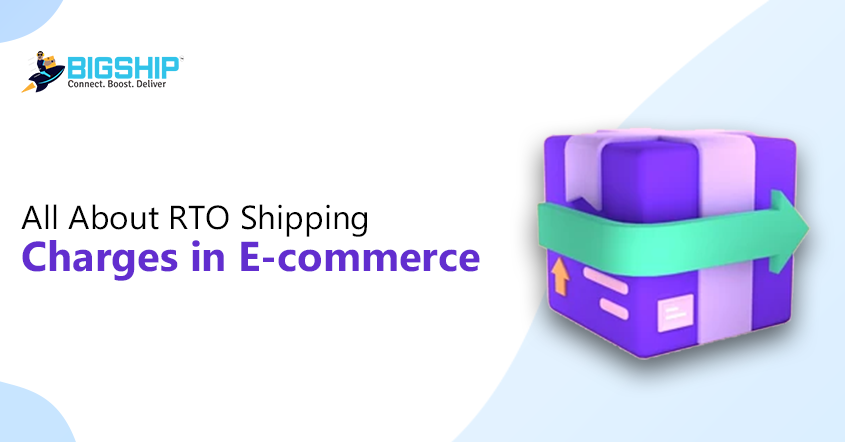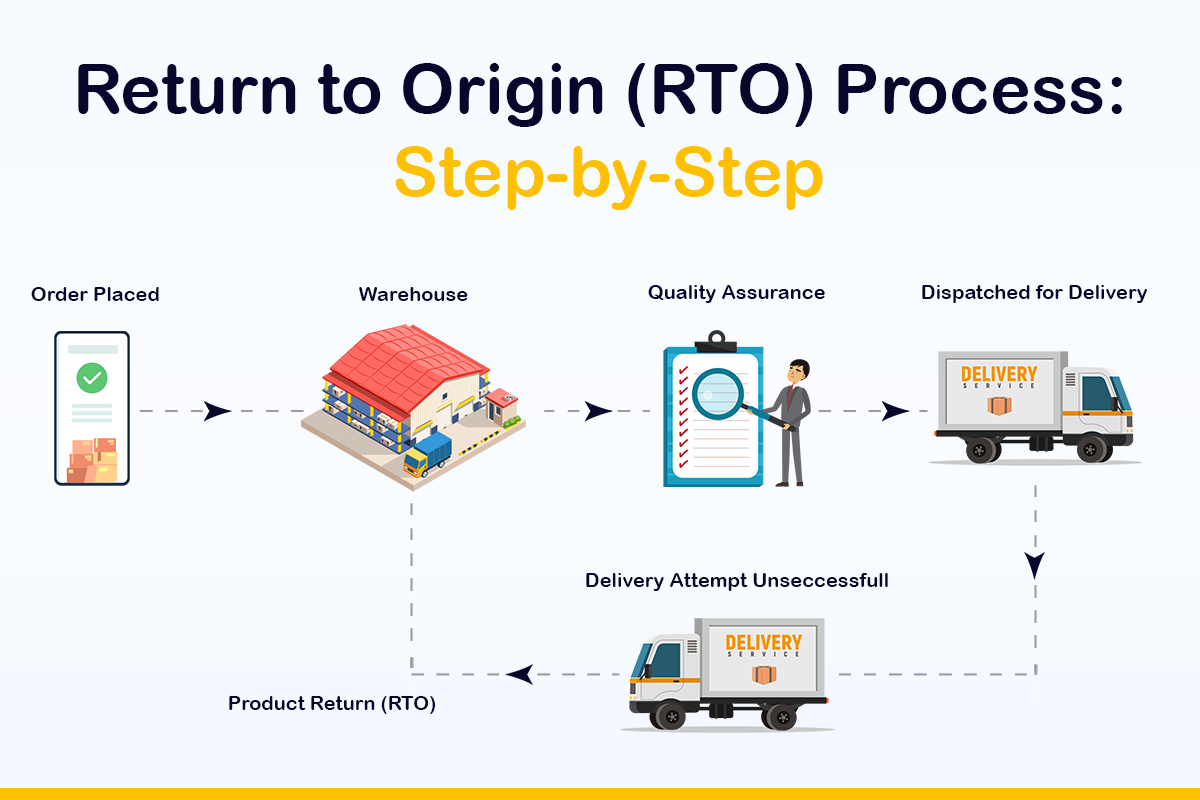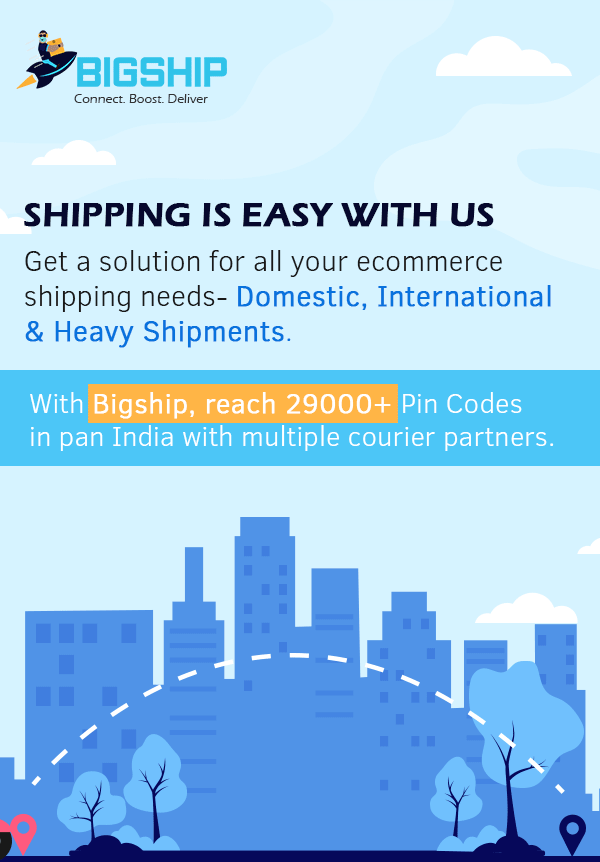All You Need To Know About RTO (Return To Origin) Shipping Charges in E-commerce

Contents:
2. Causes of E-commerce RTO
3. What is the Next Process After RTO?
4. Scenarios of RTO process
5. How to Reduce RTO?
6. Conclusion
7. FAQs
Return to Origin or RTO is a crucial aspect of e-commerce logistics. This term indicates that a package cannot be delivered and is then sent back to the seller’s address. Understanding RTO is essential as it impacts businesses financially, often incurring additional costs. In our blog, we delve into the intricacies of RTO, from its definition to its processing and mitigation strategies.
Here, you can discover everything about RTO Shipping Charges in e-commerce. This guide breaks down the importance of RTO in online retail, explaining its causes and the steps taken after an RTO event. With practical strategies to reduce RTO occurrences, businesses can arrange operations and cut costs effectively. Dive into this essential resource to better manage RTO shipping charges and boost efficiency in E-commerce.
Understanding Return To Origin

Return to Origin (RTO) is a vital concept in eCommerce shipping. It refers to the inability to deliver a package, necessitating its return to the seller’s address. This typically occurs when recipients are unavailable during delivery attempts. RTO impacts businesses financially, incurring additional costs. Thus, minimizing RTO rates is crucial for a healthy bottom line. Lower RTO rates signify smoother operations and cost efficiency.
Power Your E-commerce Growth with Bigship
Your trusted partner for ecommerce brands of all sizes.
By ensuring successful deliveries, businesses mitigate expenses associated with returns and reshipments. Strategizing to minimize RTO involves optimizing delivery processes, enhancing recipient communication, and streamlining logistics. Ultimately, a lower RTO rate signifies operational excellence and enhances customer satisfaction. In essence, understanding and addressing RTO challenges are integral to sustaining a thriving eCommerce enterprise.
Causes of E-commerce RTO
Several factors contribute to Return to Origin (RTO) instances in eCommerce, each impacting delivery success and operational efficiency.
Recipient Unavailability: Often, recipients are not present during delivery attempts, leading to RTO. This could arise from conflicting schedules or inaccurate address information.
Address Errors: Incorrect or incomplete addresses can hamper delivery, causing RTO. Address validation tools and data verification can mitigate this issue.
Failed Delivery Attempts: Inefficient delivery attempts due to factors like inaccessible locations or restrictive delivery hours can result in RTO, emphasizing the need for flexible delivery options.
Refusals: Recipients may refuse deliveries due to various reasons such as damaged packages or unexpected expenses, ultimately triggering RTO processes.
Courier Errors: Mistakes by courier agencies, like misrouting or mishandling packages, can lead to non-delivery and subsequent RTO.
Customs Issues: International shipments may encounter customs clearance issues, resulting in RTO if not resolved promptly.
What is the Next Process After RTO?
In e-commerce, after a shipment is RTO, it may not necessarily be returned to the seller’s address immediately. There are several actions that can be taken after your shipment is RTO, some of them are mentioned below.
Re-attempted Delivery: Courier services typically make up to 3 additional delivery attempts to fulfill the order. This allows for flexibility in scheduling and ensures maximum chances of successful delivery.
Customer Communication: Couriers or sellers may contact the customer directly to arrange a convenient delivery time. Text messages or Interactive Voice Response (IVR) calls are common methods used to gauge customer availability and preference regarding the parcel.
Confirmation or Decline: If the customer cannot be reached or declines the delivery, an RTO is initiated. This indicates the package’s non-deliverability and triggers its return to the seller’s registered address.
4 Scenarios of RTO process
Return to Origin (RTO) processes vary based on the nature of the shipment, typically categorized into four scenarios:
1. Reship with Expectation of Return: In this scenario, the sender reships the package immediately, anticipating its return.
2. Reship without Expectation of Return: Here, the sender reships the package promptly without expecting its return.
3. Wait for Return and Reship: The sender waits for the package to return before reshipping it.
4. Wait for Return and Cancel: The sender waits for the package’s return and cancels the order accordingly.
When the recipient is unavailable, courier companies make multiple attempts and contact the recipient before marking the shipment as RTO. Subsequently, the package is returned to the sender’s warehouse.
How to Reduce RTO?
Reducing Return to Origin (RTO) rates involves delivering orders promptly, confirming addresses, maintaining communication with customers, and using AI for efficient delivery management. Timely deliveries and accurate address verification prevent returns. Continuous updates through tracking notifications minimize unavailability issues and reduce support inquiries. Leveraging AI streamlines undelivered package management, optimizing reattempts. These strategies aim to reduce RTO in ecommerce while simultaneously enhancing customer satisfaction, loyalty, and operational efficiency, thereby mitigating associated costs for sellers.
Conclusion
In conclusion, understanding and effectively managing Return to Origin (RTO) shipping charges are paramount for success in the dynamic realm of e-commerce. By grasping the details of RTO and implementing proactive measures to address its causes, e-commerce businesses can optimize their operations and minimize financial implications.
Reducing RTO rates involves addressing address errors, improving customer communication, and utilizing AI-driven logistics. Moreover, by embracing strategies outlined in this guide, such as timely deliveries and streamlined reattempts, businesses can foster operational excellence and bolster customer satisfaction. Ultimately, a lower RTO rate not only signifies cost efficiency but also reflects a commitment to delivering exceptional experiences to customers. As e-commerce continues to evolve, effectively managing RTO shipping charges remains the basis for sustainable growth and success in the e-commerce marketplace.
Return To Origin (RTO): FAQs
Ques: What does RTO mean?
Ans: RTO, short for “Return to Origin,” refers to the process of returning a product to its seller or point of origin. This commonly occurs when delivery fails, addresses are incorrect, or recipients are unavailable, prompting the product’s return to the shipper’s warehouse.
Ques: What is return to origin charges?
Ans: Return to Origin (RTO) charges are incurred when a package is returned to the seller’s warehouse or fulfillment center due to unsuccessful delivery attempts or customer returns.
Ques: What is the difference between return and RTO?
Ans: Returns and RTO (Return to Origin) both involve products going back to sellers. However, returns occur when customers voluntarily send items back, often due to dissatisfaction or other reasons. RTO, on the other hand, happens when packages cannot be delivered successfully, leading to their return to the seller’s warehouse, typically due to issues like incorrect addresses or recipient unavailability
Ques: How to reduce RTO?
Ans: To reduce RTO rates, delivery companies need to ensure accurate address entry, optimize delivery processes for flexibility, and communicate effectively with customers regarding delivery schedules. Technology like AI can be utilized for efficient logistics management and provide real-time tracking updates. Streamlining operations and enhancing customer support can also minimize RTO occurrences effectively.
Ques: What is the RTO process in courier?
Ans: In the courier RTO process, when a package cannot be delivered successfully, the courier company makes multiple delivery attempts and contacts the recipient. If unsuccessful, the package is marked as RTO and returned to the sender’s warehouse. The return process is governed by the agreement between the shipper and courier partner.





